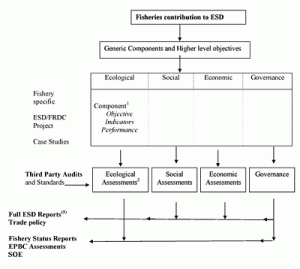Other Reporting Requirements
Relationship of National ESD Reports with Other Reporting Requirements
In addition to each fisheries jurisdiction having to meet government commitments to Ecologically Sustainable Development (ESD), there are a number of additional requirements for information that include some, or all, of the components of ESD (see Table).
During the last few years, changes to the legislation (or regulations) of Commonwealth agencies (e.g. DEWHA, Great Barrier Reef Marine Park Authority), and non-fishery agencies within some jurisdictions also requires fisheries activities to be assessed against various aspects of ESD. In addition, there has been an increased focus on the potential for eco-labelling in the development or maintenance of [export] markets.
The changes to Schedule 4 of the Wildlife Protection (Regulation of Exports and Imports) Act (1982) (which affects the ability to export a species) and the newly created Environmental Protection and Biodiversity Conservation Act 1999 (which affects all Commonwealth fisheries &/or fisheries which impact upon “matters of national environmental significance” and protected species) requires affected fisheries to undergo an assessment against their guidelines for sustainability.. These guidelines are largely based upon the Marine Stewardship Council guidelines [4] (MSC, 1999), and only cover environmental components and a restricted number of governance issues, therefore ignoring social and economic issues.
In some jurisdictions, agencies other than the fisheries department may have legislative requirements to assess the adequacy of the fisheries management arrangements. For example, all commercial fisheries in NSW now need to be assessed against a set of guidelines from its Environmental Protection Act. Moreover, the decision-making process for development applications, or continued access of aquaculture developments, usually involves submission of assessments to more than one government agency.
Non-Government accreditation processes are also evolving within the fisheries management landscape. For example, the Marine Stewardship Council (MSC) process is designed for industries wanting to gain independent environmental accreditation to assist with market access issues or enhanced market leverage for their products. The concept has been adapted from a similar process available for forestry industries, with an assessment against a set of guidelines that examines the sustainability of a fishery with respect to its impact on the target species, the impacts on the rest of the ecosystem and the management arrangements that ensure this sustainability.
The first fishery in the world to be accredited under this MSC scheme was the Western Australian Rock Lobster Fishery. It is unknown how much of an impact such accreditation will have on the marketing opportunities for fisheries. Presently such assessments have been focused on the environmental aspects of resource management (e.g. the Marine Stewardship Council accreditation), but there is a strong possibility the future assessments carried out by the World Trade Organisation may include ones carried out on the social and economic impacts of production.
Thus there are a number of processes and legislative requirements based on the assessment of some or all aspects of ESD (see Table). Given this variety of requirements, it is important to develop a conceptual framework that incorporates all these issues and can assist with any or all of these needs – thereby minimising the level of duplication.
Finally, there are also developments associated with gaining market access or increased leverage for industry by obtaining environmental accreditation for their products.
Consequently, there are a large number of reasons why ESD assessments need to be completed, but an even greater need to ensure that the reporting schemes developed are sufficiently comprehensive to restrict the level of duplication. This does not mean that all elements of ESD have to be assessed and reported at the one time.
A staged approach is possible, whereby the most urgent reporting needs are dealt with by only completing the ESD components necessary for a particular application (See Figure). Thus, if an application is needed for an environmental purpose, only the environmental and governance components need to be addressed.

Relationship Between ESD Reports and Meeting Other Requirements
5 – Qualitative Risk Assessment
2 – Quantitative Risk Assessment
3 – Risk Assessment across all elements
[4] See www.msc.org/templates/template1.asp?page=26 for MSC guidelines

